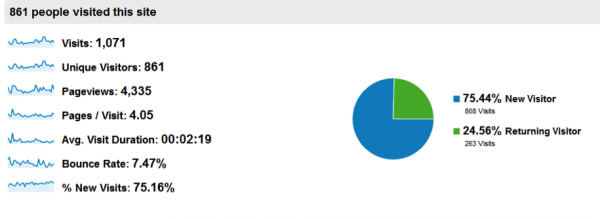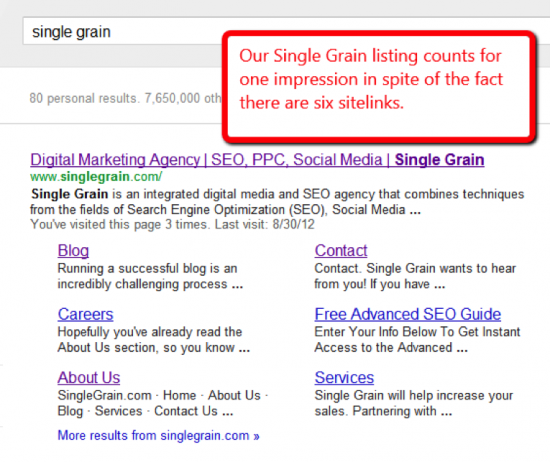I love SEO and I also love all of the algorithm changes Google has made over the last decade. It really makes my job challenging, and keeps me on my toes.
For example, when I first got into this business the SEOs number one goal was to get client websites to the top of search rankings. It was a pretty easy sell if you could do it. Your value proposition amounted to this: I’ll help you rank for these keywords by doing A, B and C. And it was really easy to report on, too. All your client had to do was search Google for those keywords and see where their pages were positioned.
Of course back in the day SEOs real struggle was to get clients to relax—it took time to rank high! Now our struggle is to get clients to STOP thinking about rankings. Google has made hundreds of changes, mostly small ones, but also huge ones that have changed the ranking landscape, Search+ being the biggest.
That change alone started delivering personalized search results to Google users that were based on criteria like their search history, friend’s search history, location, brand mentions and social web use (especially Google+).
What this all boils down to is the fact that if four different people search “mountain bike” then they’ll see four different search results page. Consistency in ranking report is out the window. Search+ killed it.
So what reports should you use in place of rankings? Here are six essential reports that you can pull from both Webmaster Tools and Google Analytics.
Visitor Growth

A more usable web analytic report to gauge your SEO success in this new Search+ world is “visitor growth.” This is a simple report. If your SEO efforts are working, then the trend should be up. You should be getting more visitors. If your efforts are not working, then the trend will be flat or downward.
This report will also help you calculate how many qualified leads your clients can expect from this traffic. It tells you or your client how many people to expect to reach you.
You do have to be honest about what you see and report. For example, if you see 1,000 unique visitors at your site every day for a 30 day period, then the question you next have to ask yourself is are these new or returning visitors every day? The answer will impact how you report on the visitor growth.
 This web analytic report is your baseline growth metric. Check it to determine how well you are pulling in new visitors and bringing back repeat visitors. If you run a blog, this will also help you determine if your content is compelling.
This web analytic report is your baseline growth metric. Check it to determine how well you are pulling in new visitors and bringing back repeat visitors. If you run a blog, this will also help you determine if your content is compelling.
Impressions
This used to be a metric that many SEOs didn’t take all that serious. Impressions only amounted to possible views given your search listings would emerge under a particular search query. In the old days of Internet marketing we talked about eyeballs. The higher the impressions the more an advertiser could charge. But then companies got wise to this trick and started demanding hits—or clicks.
So why are impressions important now given the changes to the SEO landscape? The shift to impressions gives us an idea on how our pages are showing up for comparative search terms. Being number one is important, and something we’d all want, but not nearly possible with different range of search listings that are going to be rendered per individual. The question now becomes: is that page even showing up for keywords X, Y or Z? And where is it showing up?
It’s important you understand what “impressions” mean, however. A precise definition is essential for proper tracking. Google doesn’t calculate organic search impressions the way you might expect. There are two things at play with impressions:
- A listing with sitelinks will count as one impression—no matter how many sitelinks show up under the top level URL.
- Two separate listings, however, from the same top level domain will count as two separate impressions.
If you search Google with “single grain,” the name of my SEO company, this is what you will get:

Search for “sujan patel SEO” however, and you will get two separate listings for the top level domain singlegrain.com:

And then further down the page:

Why is this important? Click on any of the links with the sitelinks—whether the top level URL or the sitelinks—and that would count as a click for the top level page. This skews your impression-to-click ratio, so you’ll have to adjust it to deliver accurate reports.
Average Rankings
Back in late January of this year Google announced changes to how they would score your average ranking. Here’s how they explained it:

The old way of reporting didn’t matter that much. But now it does for the positive. It will in fact be a closer approximation of “how a link’s position in Google search results should be reported.”
Why is this important? This is one way to satisfy the client who won’t stop talking about rankings—you can show him or her this report and assure them that overall you are doing better or worse.
Conversions
A conversion is the successful completion of a goal that you’ve set up in Google Analytics. Examples of goals include things like subscribing to an email newsletter, ordering a product from your e-commerce site or a simple view of an important landing page.
Tracking conversions will allow you to see how your ads and keywords are performing together. Are people clicking through to the product page based on a set of keywords? Are people abandoning the subscribe page because of another set of keywords? Conversion tracking will show you how your SEO efforts are actually performing in the real world.
Conversion tracking is also important because it helps you build your ROI. Which keywords bring you the most leads? Conversion tracking will tell you. You can measure conversions based on either a 1-per-click or many-per-click.
- One-per-click – When you are trying to calculate how many leads you are getting per sign up, then you’ll want to track this goal with the one-per-click. Each time the goal is successfully completed you’ll see a conversion. This is true for a 30-day period. What you won’t see are clicks that occur beyond that initial click.
- Many-per-click – When you are trying to calculate conversions such as purchases that don’t terminate on a single click (for example, click “order” button on landing page, click to select size, color, etc. of product, click order, click survey and click back button), then you’ll build a many-per-click goal.
Exact match
In the PPC world, exact match is exactly how it sounds. It’s an exact match of your target URL. So if you were targeting /subscribe.html, then you will get reports only delivered on that URL. The same is true with Google Analytics exact match. A goal URL like /subscribe.html will tell Google Analytics to record any time there is an exact match with that URL. Google Analytics will not even match /subscribe. It has to be /subscribe.html. You’ll have to instruct Google Analytics to record separate goals.
So why is this important? For new businesses or old business who are going through a rebrand, this will allow you to see how local search is affecting your SEO strategy. Can you fit the city name in the URL to up your conversions or get more eyeballs on the page?
Established brands will want to avoid domains stuffed with no-descript keywords. Instead, use your brand name to build upon your SEO efforts.
Regular expressions match
Finally, the last metric you’ll want to look at is the “Regular Expressions Match.” By leveraging Regular Expressions, this match type will give you the power to do some pretty neat stuff with all of your URL goals. For example, you can combine all of your multiple URLs in the same goal slot or make Google Analytics to identify your goal URL with either the start or ending of an URL.
Here’s how that works. Let’s say you want to identify a goal in Google Analytics any time a page starts with /subscribe. You’ll have to use the Regular Expression Match type. Then type in: ^/subscribe.
So Google Analytics now knows that you want to identify any page that starts with /subscribe. That could be /subscribe/newsletter, /subscribe/blog, /subscribe.html or /subscribe.htm?id=234.
You won’t get numbers pulled for queries like this: /blog/subscribe, /newsletter/subscribe or /content/subscribe. To pull this data you’d use the $ symbol to match a URL with that ending.
Conclusion
We’ve definitely reached an age in the SEO world where boning up on your analytic skills is essential to success. You can easily out distance a competitor by demonstrating to potential clients the very specific SEO path you will take to help them grow their business—and now you’ll have the metrics to prove that you can actually do this.
What other reports do you think are important now that Search+ has taken away rankings?
Hi Mr. Patel,I really wanted to learn all about what you are sharing with me regarding Google Analytic, SEO,URL.Search+ etc. But honestly, I really could not understand all those things. I think, I need a great time to study and that’s my problem, my time is so limited. Anyway, I really appreciate it. Maybe, one at a time I would try to seat in front of my PC more time to learn from you. I’m sure it will help me grow in knowledge and in my business. Thanks a lot! menchu
Hi Sujan, it’s first time I came to know about you and for that I would like to thank you for sending a great gust article at the Neil’s blog.
I learned a lot because I was seeking more information about social media and here at your blog in this article I came to know that how the search is changing and making SEO job tough day by day.
Search + is yes give us a great support to target traffic but we cant measure them how they come form our website , what they search on Google for our website :s
[…] Patel offers some other methods of tracking how your websites are performing, all of which can be found in […]
Super read and thanks for taking the time to write such a long piece. well done
Very helpful, please add me to your update list.
Many thanx…b
This site was… how do I say it? Relevant!!
Finally I have found something which helped me.
Kudos!
Comment (7) - Cancel Reply